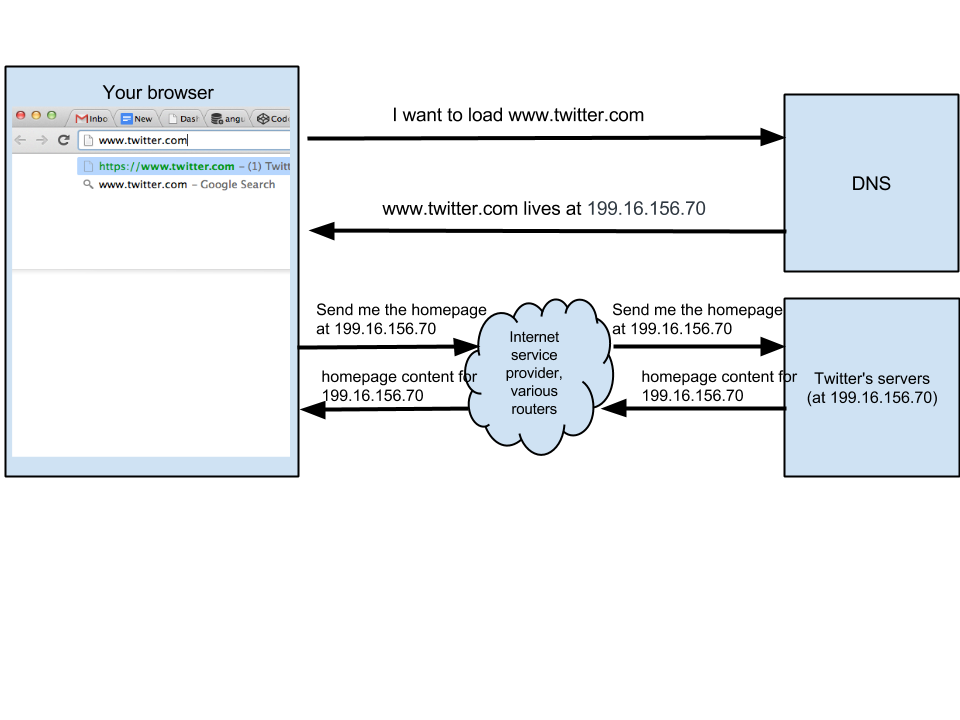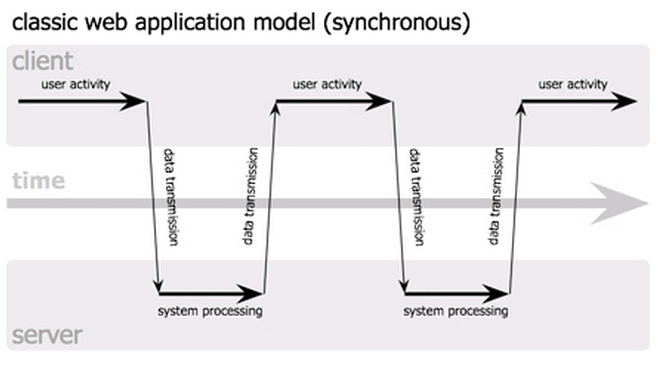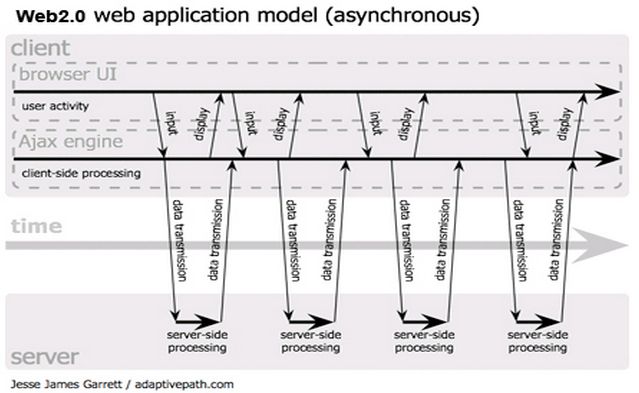
AJAX and JSON
Agenda
Today we will look into
- Recap: HTTP / HTTPS
- JSON
- AJAX
- Promises

Communication between computers
- Computers communicate with each other with HTTP/HTTPS.
- Computers can be clients or servers.
- The client sends a request to the server.
- The server sends a response back to the client.
What is HTTP?
- hypertext transfer protocol
- Protocol used for websites to transfer HTML, CSS, JS, images and text
HTTP requests
- GET: I receive the Twitter feed with all tweets from today
- POST: I create a new user which is added to the server
- PUT: I edit a tweet I made before
- DELETE: I delete a tweet or my user account
HTTP responses
- Status Code, e.g. 200 (OK), 404 (Not found), 500 (Server error)
- Data, e.g. HTML, CSS, JS, images and more
Have a look at the network tab in your code inspector.
HTTPS
- hypertext transfer protocol secure
- The data is encrypted between client and server using a secret key.
- The technology used is today the transport layer security (TLS) and before was the secure sockets layer (SSL).
Data formats
Standard formats to send data over the internet and receive it
- Plain text
- HTML
- XML
- JSON
XML
eXtensible Markup Language
XML uses tags to define its structure similar to HTML and SVG.
Tags are not predefined, you can specify your own tags.
Nested tags are possible.
XML example
<person>
<name>Susanne</name>
<surname>Koenig</surname>
<nationality>German</nationality>
<languages>
<language>German</language>
<language>English</language>
</languages>
</person>JSON
JavaScript Object Notation
JSON is a lighweight, readable format for structuring data.
It is a modern alternative to XML to transmit data from server to client.
JSON is a string whose format very much resembles JavaScript objects.
JSON example
{
"name" : "Susanne",
"surname" : "Koenig",
"nationality" : "German",
"languages" : ["German", "English"]
}Like a JS object JSON maps keys to values.
Always use double quotes "" in JSON.
Why JSON?
- JSON is easier to parse and use with JS
- JSON saves bandwidth
- JSON improves the response time
- JSON is the standard today
JSON in JavaScript
const obj = JSON.parse('{"name": "Susanne","surname": "Koenig"}');
let myJSON = JSON.stringify(obj);JSON.parse() is a built-in JavaScript method to turn JSON into a JavaScript object.
JSON.stringify() is a built-in JavaScript method to turn a JavaScript object into a JSON.
AJAX
HTTP can also fetch only part of documents to update web pages on demand. Without reloading.
Google came up with that in 2006.
AJAX
Asynchronous Javacript and XML
It combines a group of existing technologies: HTML, CSS, JavaScript, XML, etc.
Together this group can build modern applications.
JavaScript
- initiates the AJAX request
- parses the AJAX response
- updates the DOM
The old way
XMLHttpRequest
Also known as XHR API is used to make a request to a server.
API: Application Programming Interface is a set of methods which specify the rules of communication between two interested parties.
Note: The incoming data does not need to be in XML.
XHR example
var request = new XMLHttpRequest();
request.open('GET', '/path/to/api', true);
request.setRequestHeader('Content-type', 'application/json'); // Not for text + HTML
request.onload = function() {
if (request.status >= 200 && request.status < 400) {
console.log(JSON.parse(request.responseText));
} else {
// We reached our target server, but it returned an error
}
});
request.onerror = function() {
// There was a connection error of some sort
};
request.send();The new way
fetch API
fetch("https://jsonplaceholder.typicode.com/todos/1")
.then(response => response.json())
.then(data => console.log(data));fetch
- returns a promise: I promise to let you know when the response of my request is returned
- then it returns a response: with its own method
json()to parse the response - then it returns a object: with the data of your AJAX call
Promises
new in ES6
A promise is an object that may produce a single value some time in the future. Either a resolve value, or a reason why it's not resolved (rejected).
Callbacks
button.addEventListener("click", submitForm);Once the button is clicked, the function submitForm will be called.
Nested callbacks
movePlayer(100, "left", function(){
movePlayer(200, "right", function(){
movePlayer(400, "left", function(){
});
});
});Once the player moved 100 steps to the left and that is done, the player should move 200 steps to the reight and then this move is done, the player moves 400 steps to the left again.
= pyramid of doom (repetition of code, difficult to read)
movePlayer with promises
movePlayer(100, "left")
.then(() => movePlayer(200, "right"))
.then(() => movePlayer(400, "left"));Better, but still hard to read
Different syntax
const promise = new Promise((resolve, reject) => {
if(true){
resolve('Stuff worked');
} else {
reject('Error, it broke');
}
})
promise.then(result => console.log(result))Error handling
promise
.then(result => result + "!")
.then(result2 => result2 + "?")
.then(result3 => {
throw Error;
console.log(result3)
})
.catch(() => console.log("error!"));Promises are used for asynchronous JavaScript.
The dot syntax here is called chaining
Asynchronous JavaScript?
To understand asynchronous JavaScript, we need to understand synchronous JavaScript first.
Until now all our JS was synchronous: you run some code and the result will bet returned as soon as the browser can do it.
Synchronous JavaScript
While an operation is processed (calling a function for example), nothing else can happen - remember alert?
Reason for that is that JS is single-threaded. All tasks run on the main thread like pearls on a necklace.
Synchronous workflow

Asynchronous JavaScript
Often you need to wait inside a function for sth. to happen, for a response, before you can move on.
If you fetch an image from a server via JS for example, you cannot use that image right away - it has not been downloaded yet.
Asynchronous workflow

Online ressources
Exercises
Convert arabic numbers to Roman
Write a function to convert from arabic (normal) numbers to Roman Numerals. The Romans wrote numbers using letters: I, V, X, L, C, D, M. There is no need to be able to convert numbers larger than about 3000.
Example: 7 returns VII
Create a background gradient generator
- Create a simple HTML file with the tags needed (see PDF of final generator)
- Add the basic CSS file style.css and edit it to add a default gradient in the background
- Add a JavaScript file
- For each color of the gradient change the background gradient style with the new colors
- Additionally output the gradient style to the HTML (see PDF of final generator)
Promise.all()
Look up how Promise.all() works and then call several JSON APIs (see JSON placeholder website in online ressources) and log the results.